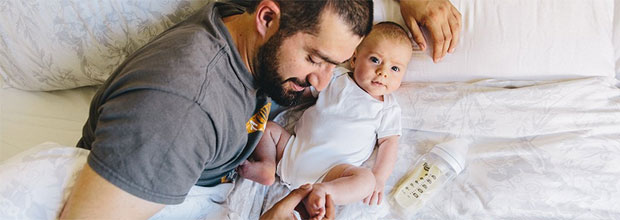Introducing a Bottle to Your Baby – Tips & Advice

Introducing a Bottle to Your Baby – Tips & Advice
There are many reasons why you may consider introducing your baby to a bottle. For example, you may want to start using a bottle so that you can feed your baby expressed breastmilk when needed. You might know that you will need to leave your baby when returning to work soon and you want to ensure they have some milk while you’re away from them and can relax knowing that they will accept a bottle then.
I expressed milk with both my babies from about two weeks post-partum and kept offering them a drink of breastmilk from a bottle at the same time so that they would get used to bottles and accept them when needed.
Whatever the reason, this guide is here to help you when introducing a bottle to your baby and contains tips and tactics that you can use if you’re struggling to get your baby to accept one.
- Giving your baby their first bottle
One common issue when babies are being introduced to a bottle is that they will need to use a different sucking action compared to when they breastfeed. This means that it might take some time for them to get used to this new feeling.
To help them, look to give your child their first few bottles when they are relaxed and happy as opposed to instances when they’re hungry and more likely to want to get fed by a method that they are used to.
Another thing to try is to offer your baby a bottle in the evening after their regular feeding and just give them a small amount to get them used to the bottle’s nipple.
Some babies are more likely to accept a bottle from someone other than their mother which makes sense — why would they need a bottle when you and your milk-filled breasts are right there, they might think! It may even be best if the mother is out of the house while the baby is learning to bottle feed, as many babies can smell their mother even from a distance.
Don’t force your baby to feed from the bottle and let them guide you and let you know when they’ve had enough. You want the transition to be smooth — your child will be more likely to rebel if they aren’t enjoying their bottle in the early stages and you don’t want that.
- What to do if your baby is resisting the bottle
Some babies struggle with the transition from breast to bottle but there are some techniques you can try to help them.
Take the time to find a suitable product for your baby. If your baby has a dummy, a bottle with a similar nipple is more likely make it more appealing to your little one, for instance. A slow-flow nipple is also a good thing to look out to mimic the flow from the breast.
A First Sippee Transition Cup from Tommee Tippee ticks all of these boxes, not to mention the fact that they are specially designed for a baby’s first sips and has a super soft spout that is gentle on your child’s sensitive gums. These cups may well be known to you, following a dad’s desperate search last year to find a replacement cup for his autistic son. The plea received over 12,000 retweets and the full story can be read on the BBC website.
It’s not just the design of the bottle or cup that can help your baby with the transition. Your baby may start sucking from the cup or bottle’s nipple if you place some breast milk on it and your child tastes it and enjoys the familiar taste.
Just keep trying and let your baby get used to their new bottle or cup in their own time. Don’t be too quick to take the product away from them if they begin to chew on the nipple — let them do this for now as they may switch to sucking on it once they are familiar with the feeling.
It’s also worth trying a few different types of bottles and teats as you might find that your baby is more accepting of some than others. I’ve tried many bottles and there were a few that were very breast-like that my breastfed daughters really liked and accepted easily.
Babies may also feel more comfortable drinking from a bottle or cup when they are held in a different position to how you breastfeed them. Feed them from a bottle or cup when they are in a semi-upright position in a car seat or try having them on your lap, with their back to your chest. Be experimental and see what works for you and your baby. My youngest loved sitting in her car seat when having her bottles when she was an older baby.
Hopefully with this advice, your baby will be reaching for his bottle or cup for their feed before you know it. It’s very possible to successfully combine bottle and breastfeeding — you just need to find the products and the techniques that work for you and your baby.
Thank you to Tommee Tippee for sharing their tips with me.




